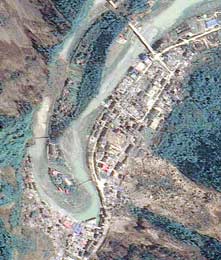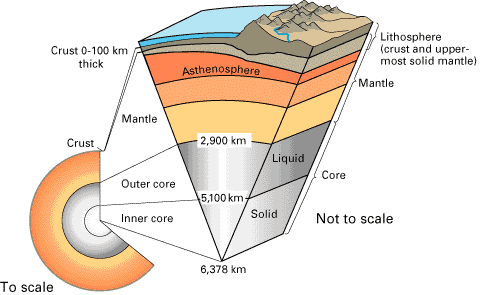In Plate Tectonic Theory, the lithosphere is broken into tectonic plates, which undergo some large scale motions. The boundary regions between plates are aptly called plate boundaries. Based upon their motions with respect to one another, these plate boundaries are of three kinds: divergent, convergent, and transform.
Divergent Boundaries:
Divergent boundaries are those that move away from one another. When they separate, they form what is known as a rift. As the gap between the two plates widen, the underlying layer may be soft enough for molten lava underneath to push its way upward. This upward push results in the formation of volcanic islands. Molten lava that succeeds in breaking free eventually cools and forms part of the ocean floor.
Some formations due to divergent plate boundaries are the Mid-Atlantic Ridge and the Gakkel Ridge. On land, you have Lake Baikal in Siberia and Lake Tanganyika in East Africa.
Convergent Boundaries:
Convergent boundaries are those that move towards one another. When they collide, subduction usually takes place. That is, the denser plate gets subducted or goes underneath the less dense one. Sometimes, the plate boundaries also experience buckling. Convergent boundaries are responsible for producing the deepest and tallest structures on Earth.
Among those that have formed due to convergent plate boundaries are K2 and Mount Everest, the tallest peaks in the world. They formed when the Indian plate got subducted underneath the Eurasian plate. Another extreme formation due to the convergent boundary is the Mariana Trench, the deepest region on Earth.
Transform Boundaries:
Transform boundaries are those that slide alongside one another. Lest you imagine a slippery, sliding motion, take note that the surfaces involved are exposed to huge amounts of stress and strain and are momentarily held in place. As a result, when the two plates finally succeed in moving with respect to one another, huge amounts of energy are released. This causes earthquakes.
The San Andreas fault in North America is perhaps the most popular transform boundary. Transform boundary is also known as transform fault or conservative plate boundary.
Movements of the plates are usually just a few centimeters per year. However, due to the huge masses and forces involved, they typically result in earthquakes and volcanic eruptions. If the interactions between plate boundaries involve only a few centimeters per year, you could just imagine the great expanse of time it had to take before the land formations we see today came into being.
You can read more about plate boundaries here in Universe Today. Here are the links:
- Tectonic Plates
- Lithosphere
Here are the links of two more articles from USGS:
Here are two episodes at Astronomy Cast that you might want to check out as well:
Sources:
Plate Boundaries
http://pubs.usgs.gov/gip/dynamic/understanding.html




